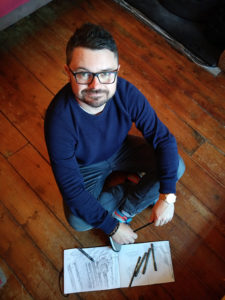 This month’s interview is with author/illustrator Duncan Beedie, the first UK-based interview subject we’ve ever had at OPB! Don’t worry, though—I’ve installed a UK-to-American-English translator plugin, so we don’t run into any linguistic snafus!
This month’s interview is with author/illustrator Duncan Beedie, the first UK-based interview subject we’ve ever had at OPB! Don’t worry, though—I’ve installed a UK-to-American-English translator plugin, so we don’t run into any linguistic snafus!
Let’s borrow some bio stuff from Duncan himself: “I have been doodling and drawing since way back in the early 1980s, lying on my parents’ living room floor, grasping a felt tip in my clammy little fist, through to my current profession, grasping a Wacom stylus in my clammy little fist. So, not much has changed, although I no longer lie on the floor to draw.”
I first learned about Duncan via his picture book, The Lumberjack’s Beard, which I read to my kids and they said, “That beard is bonkers good.” With an endorsement like that, I knew I had to bring Duncan into the OPB fold one way or another.
So, let’s get this interview underway and learn about all things Duncan! With a little luck, we might learn something about that wondrous across-the-pond place called the UK, as well.
- Website: www.ducanbeedie.co.uk
- Behance: https://www.behance.net/user/?username=DuncanDraws
- Twitter: https://twitter.com/DuncanDraws
- Facebook: https://www.facebook.com/DBIllustration
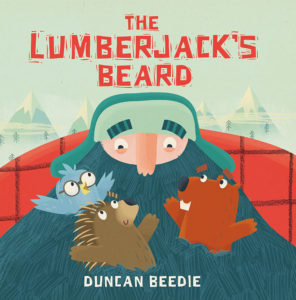 RVC: Let’s start right where my kids did—that lumberjack’s beard. With a picture book where you’re both author and illustrator, where does the story begin? With a title, an image, a phrase? (It’s the beard, right? You can tell us.)
RVC: Let’s start right where my kids did—that lumberjack’s beard. With a picture book where you’re both author and illustrator, where does the story begin? With a title, an image, a phrase? (It’s the beard, right? You can tell us.)
DB: I always start with a character design. I consider myself more of an illustrator than a writer, so doodling in a sketchbook always comes first. Then, if there’s a character I particularly like, I start to develop a world for him/her. I think about that character’s routine, what they might wear or eat, and hopefully a story idea emerges. That was certainly the case with “Big” Jim Hickory in The Lumberjack’s Beard.
RVC: One of the things I’ve noticed in looking at picture books by UK publishers (like Templar Books, which published many of your titles) is that there’s a stylistic difference from picture books from US publishers. What do you think? Do you see it, too? What’s this about?
DB: I’m afraid to say I haven’t looked closely enough at enough US picture books to be able to comment on the stylistic differences (my apologies!) I do, however, notice differences between UK books and their European counterparts. Particularly in terms of the illustration. I also think artists and writers vary incredibly within the UK. I haven’t a clue what accounts for this stylistic difference, but it’s great to see so much variety on bookshop shelves.
RVC: I completely agree. Variety is the life of spice, right? Something like that?
Moving ahead! I always like to know the origin story of a creative. You gave us a wonderful bio nugget in the intro, so let’s jump to another key point in your creative past—your first book. What’s the story behind it? How did it come about?
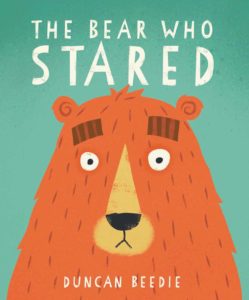 DB: The Bear Who Stared came about from an illustration as well. One day I drew a gormless-looking bear [UK translator in action here! Gormless: an informal British word, meaning “lacking in vitality or intelligence; stupid; clumsy”] as if he were posing for a passport photo. I had a printout of it in my studio and would occasionally stare at it–the gormless bear stared back.
DB: The Bear Who Stared came about from an illustration as well. One day I drew a gormless-looking bear [UK translator in action here! Gormless: an informal British word, meaning “lacking in vitality or intelligence; stupid; clumsy”] as if he were posing for a passport photo. I had a printout of it in my studio and would occasionally stare at it–the gormless bear stared back.
Eventually a story about a socially awkward bear formed in my mind. I sketched out a storyboard and sent it to a couple of publishers, and Templar Books replied stating they were interested in developing it. The rest is history, as they say.
RVC: I love the answer, but I confess–that bear’s staring is getting to me now, too! ARGH! Let’s move on as if that bear isn’t still giving me The Look…
Prior to getting into illustrating picture books, you worked in animation for 14 years. How did the skills you learned in that environment inform your work as a picture book illustrator?
DB: Quite simply, animation is a great form of storytelling. In terms of my artwork, it taught me a great deal about the storytelling process. Storyboarding in particularly made me think about pacing a narrative and how to construct a visual composition in terms of using the space available. I still use animation software (Adobe Animate CC) to draw the colour artwork for my picture books. I know there are plenty of other programs out there, but I find it so intuitive and easy to use.
RVC: In all your experience with picture books, what has surprised you the most?
DB: This might sound weird, but I’m constantly amazed by how bloody nice everyone is in the world of children’s books. Maybe I’ve just been lucky, but there’s a real community spirit among authors, illustrators, and even competing publishers. I say “competing,” but there seems to be a genuine camaraderie across the board. I came into the industry from having worked in TV and commercials, so it was a bit like moving from LexCorp to a puppy sanctuary.
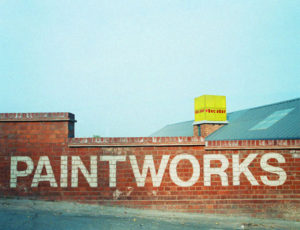 RVC: I understand that you “have a desk” at Paintworks, which seems like an artsy, hipster place with studio/offices, residential spaces, and an exhibition venue. How much work do you do there? And how does it affect your creative process, having a clear view of the city, as you do?
RVC: I understand that you “have a desk” at Paintworks, which seems like an artsy, hipster place with studio/offices, residential spaces, and an exhibition venue. How much work do you do there? And how does it affect your creative process, having a clear view of the city, as you do?
DB: Well, I see you have done your research!
I rent a desk in an animation studio called Sun & Moon Studios. I’ve known the directors for a long time and they are good friends of mine. We have recently moved to a much bigger studio that is even “hipper,” with a foosball table and “industrial-chic vibe.” However, I have lost my window view of the city, so have to make do with a photo of it as my desktop wallpaper.
I tried working from home, but it was such a solitary experience that it genuinely impacted my mental health. It’s nice to be able to socialize with fellow creative types.
RVC: What do you think is the most common misconception about freelance illustrating?
DB: That we sit around in cafés with MacBooks, eating artisan poppy seed bagels, whilst wearing gaudy knitwear and big hooped earrings, and stroking cats. Although, like most clichés, there must be enough truth in this scenario to warrant the cliché status.
RVC: Though your description there is a 100% match with every single artist I know, I take your point. It could just be me and my select group here. Who can say?
Let’s talk agents. You’re repped by Jodie Hodges at United Agents. At what point in your career did you secure representation, and how vital is it for young artists to do the same?
DB: I was initially repped by Illustration Ltd (from 2011) and it was great to have a team with their expertise fighting in my corner, as it were. If I do conform to an artist stereotype, it is that I have about the same level of business acumen as a goldfish. A lot of clients (outside of publishing) seem to think of illustration as a hobby and therefore don’t value it for what it’s worth. An agent will fight to get you a fair price and have the gumption to stand up to the cheapskates.
RVC: If I asked Jodie to describe your work, what would she say?
DB: What I love about Jodie is that she has this brilliant ability to communicate what she looks for in authors and illustrators in such a clear yet personable manner–that’s a hugely important asset for an agent to have. As such, I couldn’t begin to put words into her mouth–I’d just ruin it.
RVC: Sometimes I hear people say that you can’t teach people to write. Do you think people can be taught to draw? (Note that this comes from a person who, despite working at Ringling College of Art and Design for a decade, can only draw three things—a bunny, Papa Smurf, and a vaguely three-dimensional box. Then again, I’m not on the art side of things. Maybe that has something to do with it …)
DB: I’m self taught when it comes to illustration, and I’m always learning. Some people have more of a natural talent that comes through without tuition, while others hone their skills at art college. There’s no right or wrong way, but you should never stop learning new things.
Don’t discount your Papa Smurf drawing skills. They may save your life one day.
RVC: Well, if drawing smurfs can save a life, then thank goodness I’m so good at it, right? I mean, just consider the two images below.
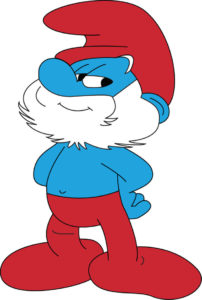
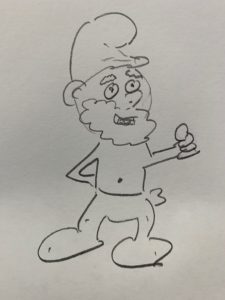
You can barely tell which is drawn by a fancy professional artist and which is done by yours truly, right? I KNOW! It’s amazing what I’ve been able to do without a single art class ever! Can you believe it?
In any case, let’s have one last “serious” question before we move on. And let’s be clear—this might be the most important question anyone has ever been asked in an interview EVER. What in the blazes are “sherbet dib-dabs”? My much-ballyhooed WordPress UK-to-American-English translator plugin is stumped at that phrase, which appears in your website bio.
Color/colour me intrigued!
DB: So, a “Sherbet Dib Dab” is a piece of candy from the UK in the 1980s, which constitutes a pouch of sherbet powder into which one dips a lolly (boiled sweet on a stick). You then lick said sherbet from the lolly and repeat this process until the sherbet is all gone and the lolly has been licked into non-existence.
At school, we used to pour the entire sherbet contents into our mouths so that they frothed up with foam. We then thrashed about on the ground to emulate a rabid fit. There was a genuine rabies scare in the early 80s so this behavior was frowned upon by teachers and parents alike.
RVC: Oh my goodness, I’m SO glad I asked. From your delicious description, the candy sounds a bit like Fun Dip. But without the rabies fakeroo, I think, which I bet made it an extra tasty experience for all involved!
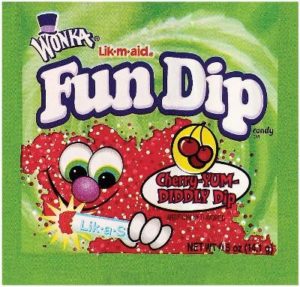
Now … no matter which side of the pond you’re on, this is what you’ve been waiting for. THE LIGHTNING ROUND! Zappy fast Qs and zippy-skippy As, please. Are YOU READY!?!
 DB: Hit me up with those gigawatts! I’m revving the DeLorean in anticipation.
DB: Hit me up with those gigawatts! I’m revving the DeLorean in anticipation.
RVC: Best place for fish and chips in Bristol?
DB: Easy! Prince’s in Fishponds. Next…
RVC: Coolest ships–Battlestar Galactica or Buck Rogers?
DB: Presuming you mean the original BG, then that one. Cylon Raiders trounce anything else in the galaxy.
RVC: What secret talent do you have that no one would suspect?
DB: It’s nerdy, but as my dad is a retired air force officer, I was obsessed with planes as a kid. I can identify pretty much any military aircraft at a glance.
RVC: What’s going to keep you up tonight after this interview?
DB: Oooooh, that’s a toughie. I may have to come back to that.
RVC: Best illustrated picture book you’ve recently encountered (by any artist not named Duncan)?
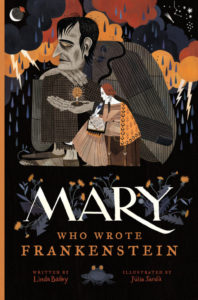 DB: I love Mary Who Wrote Frankenstein written by Linda Bailey and illustrated by Júlia Sardà. It’s a delicious slice of Gothic brilliance.
DB: I love Mary Who Wrote Frankenstein written by Linda Bailey and illustrated by Júlia Sardà. It’s a delicious slice of Gothic brilliance.
RVC: Best compliment a kid’s given your art?
DB: It’s not specifically about my art, but I remember after a book reading at a school, one kid ran up to me, hugged me round the legs, then told me he loved me and wanted me to come home with him to be his daddy. You can’t really top that. In fact, that’s probably going to be the thing that keeps me up tonight.
RVC: Thanks so much, Duncan. It was a hoot getting to know you and your work better. (For Duncan and his UK pals, I’ll offer a possible UK equivalent for the American expression “a hoot.” I’d go with “gobsmackingly bloody scrummy,” “tickety-boo,” or perhaps just the simple but tried-and-true “sick.”)


Did some work with Duncan many years ago, and have a copy of: THE BEAR WHO STARED on my bookshelf. He’s come a long way, and I’m impressed!
Thanks for dropping by, Enid. I think you’re the first UK commenter we’ve had. Yay!
And you’re right–Duncan has come a long way and he IS doing terrific work. I’m impressed, too.